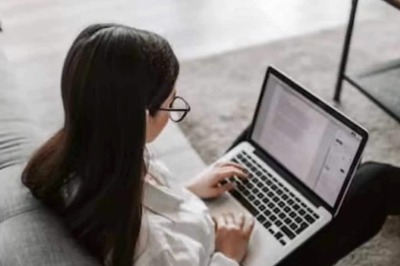
views
What are Mudra hand signs?
Mudras are symbolic hand positions. They originated in Buddhist culture between 300 AD and 500 AD, and were originally meant to represent values that are an important part of Buddha’s teachings. Mudras are thought to help channel energy through the body, and many people believe they can help you set intentions and improve focus. In art, mudras are often used as a symbol that tells the viewer something about the figure depicted, like their pursuit of wisdom. Mudras are still used today in Buddhism and other Eastern cultures, as well as in modern yoga and meditation practices. They are also an important part of Indian dances like Bharatanatyam. Anyone can use hand mudras—you don’t have to belong to any particular religion or practice.
In Mudras, each finger symbolizes an element. When you touch one finger to another, it represents a connection between those elements. Here’s what each finger stands for: Thumb: Water Index finger: Space Middle finger: Earth Ring finger: Fire Pinky finger: Air
Common Mudras and Their Meanings
Gyan: Improve concentration and deepen spirituality Gyan is one of the most recognizable hand mudras. To perform it, make a circle with your thumb and index finger, touching them together lightly. Hold the rest of your fingers so that they’re straight, but relaxed, and turn your hand so your palm is facing up. Gyan is often used to improve memory, concentration, and spiritual experiences. Important religious figures like Buddha and Christ are often shown holding their hands in the Gyan mudra position.
Prana: Reduce anxiety and gain confidence Touch the tips of your ring finger and pinky finger to the tip of your thumb. Hold your index finger and middle finger up straight. Prana is often used to help reduce anxiety and improve energy. You can also use prana to give you more courage or self-confidence. Try using Pran during a root chakra meditation to help you feel more grounded.
Apana: Get more energy Turn your palms upward and touch the tips of your middle and ring fingers to the tip of your thumb. Keep your index and middle fingers straight. Apana is thought to improve digestion and energy. Variation: After you touch your middle finger and ring finger to your thumb, fold your index finger in until it touches the base of your thumb.
Shuni: Practice patience Hold your hand so your fingers are facing up and your palm faces away from you. Touch the tips of your middle finger and thumb together so they form a circle, keeping the rest of your fingers straight. Shuni, also called shoonya, is often used to help improve concentration, wisdom, intuition, and patience.
Dhyana: Deepen perception Hold your hands in your lap with your palms facing upward. Put your right hand on top of the left, and touch the tips of your thumbs together so they form a triangle. Dhyana symbolizes symmetry and is thought to help improve concentration. Try using Dhyana to enhance a loving-kindness meditation, where you intentionally send love to yourself, someone you care about, someone you're neutral toward, someone you struggle to get along with, and finally all people. In Sanskrit, the word “dhyana” means “meditation.”
Kali: Find inner strength Interlace your fingers with your palms facing together. Then, lift both of your index fingers and press them together. Use Kali when you want to remove anxiety and negativity or when you need to feel strong and mentally clear. Try a lion’s breath exercise while using the Kali mudra. Breathe in through your nose, then open your mouth and eyes as wide as you can, stretch out your tongue, and exhale with a loud roar!
Prithvi: Become more confident Gently touch the tips of your ring finger and thumb together—no need to apply much pressure. Keep the rest of your fingers straight. Prithvi is often used to help improve confidence, strength, and energy. You might use Prithvi before a job interview or a date so you can show up as your best self.
Varun: Balance fluids in your body: Touch the tip of your pinky finger to the tip of your thumb. Keep the rest of your fingers relaxed but extended. Varun is thought to help balance fluids in the body and improve perception. Try using Varun if you are struggling with a decision and you need help finding clarity.
Anjali: Calm your mind Bring your hands up near your heart. Press your hands flat together, with your palms pointed upward. This is also known as the prayer mudra, because it looks like you’re pressing your hands together in a traditional prayer pose. This mudra represents mental balance and your connection to the universe or a higher power. It may also be used as a greeting or a way of saying thank you. Anjali is usually used at the beginning or ending of a meditation period or yoga session.
How do I use mudra hand gestures?
Add a mudra to your daily yoga or meditation practice. Whether you’re new to meditating or you’ve been practicing for years, adding a mudra can help you channel an intentional energy. For instance, if you’ve been struggling with self-doubt, you might use a Kali or Prithvi mudra while you’re meditating. Mudras are often incorporated into yoga meditation to combine the benefits of both practices.
Experiment with mudras to see what works for you. Mudras aren’t an exact science, so don’t get discouraged if you try one and you don’t feel anything. They’re all about channeling the energy that already exists inside of you, so try different mudras until you find one that resonates with you. Start with these common mudras—if you find them helpful, there are hundreds more mudras that you can explore!
Do hand mudras really work?
Some people swear by mudras for mental clarity. Mudras have been used in Buddhist meditation for thousands of years to channel internal energy, improve mental and physical health, and deepen a spiritual experience. They’re not a cure-all, but it can’t hurt to add them to your own meditation or yoga practice to see if they help you feel more grounded and aware. Many people also use mudras to feel grounded, reduce anxiety, or find clarity.
Pressure in the fingertips may activate certain areas of the brain. There isn’t conclusive scientific evidence that supports mudras for improving health. However, the sensory receptors in your fingertips are linked with specific areas in the brain, and activating those receptors could potentially be used in beneficial ways—particularly to reduce stress and anxiety.



















Comments
0 comment